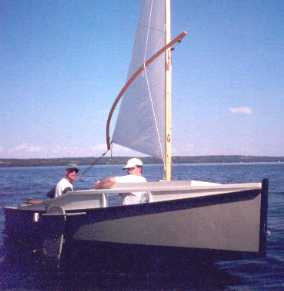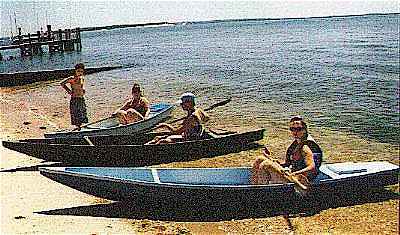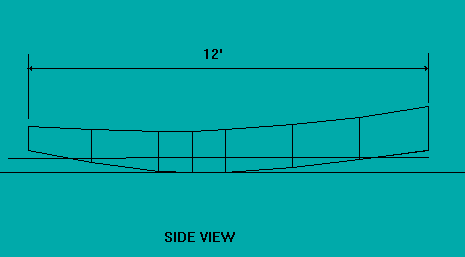
HERB MCLEOD'S AF3
Contents:
Contact info:
Jim Michalak
118 E Randall,
Lebanon, IL 62254Send $1 for info on 20 boats.
Jim Michalak's Boat Designs
118 E Randall, Lebanon, IL 62254
A page of boat designs and essays.
(1Apr99) This issue will show some ways to figure the displacement of a new design. Next issue, 15Apr99, will show ways of guessing the weight of a new design.
I've known about the Cardboard Boat Regatta down in Carbondale, Illinois, for a few years but didn't know until recently that it was open to everyone. Click on The Great Cardboard Boat Regatta Page to see the official site of the Cardboard Boat Regatta. I've got a short story about someone who tried a cardboard Toto in a race in Georgia. I warned him to use a deck to stiffen the cardboard hull and to try a test hull in the weeks before the race. He didn't but still built the cardboard Toto on the morning of the race. He led the race until the side buckled in a sharp turn (the reason for the deck suggestion). He soldiered on finishing second in a swamped boat. What was the first place prize?? - a new Pontiac!!
A WORD ABOUT COLD WATER...
Now is a good time to run the annual warning about boating in cold weather: Every Friday the St. Louis paper gives the fishing report and I read it because it gives the water temperatures of the local waters. Right now they are about 50 degrees F. Now, here is some valuable info that came with the life jacket I bought last year:
WATER TEMP:...............UNCONSCIOUSNESS................DEATH
32.5.....................................under 15 min.................................15 to 45 min
32.5 to 40...........................15 to 30 min...................................30 to 90 min
40 to 50..............................30 to 60 min...................................1 to 3 hrs
50 to 60..............................1 to 2 hrs........................................1 to 6 hrs
60 to 70...............................2 to 7 hrs.......................................2 to 40 hrs
70 to 80..............................2 to 12 hrs......................................3 hrs to indefinite
Over 80..............................indefinite........................................indefinite
If you wonder how the data was gathered click here, scroll down about 60 percent, and read. Clearly anyone falling into our local waters currently needs saving right away. There may a good chance that you won't save yourself unless you are very close to shore or can get right back into your boat. I've also heard the cold water can be completely incapacitating to the point where you MUST wear a life jacket to even float. It's quite sobering when you think about what can happen.
TEXAS MESSABOUT NOTICE...
Tim Webber is once again hosting a messabout in the Houston area on April 16, 17, and 18. For details contact Tim at tbertw@sccsi.com.
|
|
Left:
HERB MCLEOD'S AF3 |
|
|
THE VERY BASICS...
One of the real basic errors in boat design is to not match the capacity of the hull to the weight it needs to carry. It's actually pretty easily done. Let's take an example: a fellow wants a 12' skiff to handle two adults. He figures the empty boat will weigh 120 pounds and the adults together at 350 pounds. So he has to float a total weight of 470 pounds.
One thing is for sure: no matter what the shape of the hull, it will sink into the water until it pushes aside, or displaces, 470 pounds of water. (They way I heard it was that ancient Greek mathematician Archimedes figured out the basics while sitting in the bath tub.) Fresh water weighs about 62 pounds per cubic foot and salt water usually about 65 pounds per cubic foot. So the volume of fresh water displaced by the 470 pound boat is 470/62 = 7.6 cubic feet. That was easy!
Next the problem becomes one of shaping the underwater part of the hull such that it displaces 7.6 cubic feet with good flow lines.
METHOD 1: THE PRISMATIC COEFFICIENT...
We talked about the prismatic coefficent in the last issue. Remember that we construct a prism with the same length as the waterline length and the same cross section as that of the boat's maximum beam. The hull will fit neatly into the prism. Divide the volume of the underwater hull by the volume of that prism and you have the prismatic coefficient.
What is interesting to me is that the prismatic coefficient doesn't vary much from one displacement hull to another, as far as normal small boats are concerned. Jewelbox, with a flat bottom and squared off ends, has a prismatic coefficient of about .60

And Toto, with very pointy ends and multichine cross section, has a prismatic coefficient of about .50

So I figure if you were to assume a halfway normal displacement hull has a prismatic coefficient of .55 then you would always be within 10% which is actually pretty good.
So without drawing a line I might say that the 470 pound weight will need a "prism" with a volume of 7.6/.55 = 13.8 cubic feet. The prism could have any combination of cross section and length that will have that 13.8 cubic feet total volume.
Remember that the prism has the same length as the hull's waterline length and cross section as the boat's maximum cross section. Remember we want a 12' boat, but the waterline will be shorter if we want some rake to the ends (for looks) and maybe enough rocker to make sure the stem and stern don't drag the water (for low drag). We might guess that the waterline length will really be about 10'. Then the maximum cross section would have to have 13.8/10 = 1.38 square feet of area below the waterline. If we wanted a flat bottom 3' wide (wide enough to have sailing stability and narrow enough for reasonable rowing) we would have a draft of approximately 1.38/3 = .46' or 5.5".
If we wanted a different cross section than the simple box shape I'm assuming here, we would have to tinker a bit. Draw up a cross section with the 1.38 square foot cross section and see if we like it. Actually in this case I'm going to flare the sides out to 4' at the top of the wale at the cross section. But that won't affect the area under the waterline much. We might sketch out something like this:


METHOD 2: THE CURVE OF AREAS...
This method of the "curve of areas" is an accurate and flexible way of determining the volume of almost any oddly shaped thing. It's actually pretty easy to do but first you need a drawing of the proposed boat (unlike the prismatic coefficient which just needs a general idea of the boat).
Let's take our proposed boat and draw a line on it that represents 5.5" draft, our guess at what is needed to float 470 pounds. Every now and then along the length of the hull we take cross sectional cuts of the hull and measure the area at each cut below the 5.5" waterline. The cuts can be taken anywhere but there must be enough to get a good definition fo the hull. Actually for a normal boat about five cuts will do. The more you take the more accurate your work but five will get you really close. Our example boat might be like this:

The dimensions of the underwater sections are measured right off the paper drawings and the area of each is calculated like this:

Next we graph those underwater areas spacing them the same distance apart as they are on the real hull to get the "curve of area" like this:

The area enclosed under the curve of areas is a volume and is indeed the volume of the underwater hull - it's what we are looking for. In the old days you would measure the areas with a planimeter, a clever and expensive gadget. But you can do well by just breaking down the curve into triangles and trapezoids, figuring the area in each trapezoid, and adding them all up. In the example, second trapezoid from the left is figured by 1/2(175+209)X12 = 2304. Adding the sections together gives us a total of 12500 at 5.5" draft. That equates to 450 pounds of water. So the first guess was off by 20 pounds or about 4%. By the way, the drawing showed a waterline length of 9'5" instead of the first guess 10'.
As mentioned before this method can be used to figure the volume of almost anything. Let's say we wanted to find the weight of a mast. Say the mast is 24' long, 3.5" in diameter at the base and 1.5" in diameter at the top, with a curved taper between. The figuring of the volume might look like this:

1920 cubic inches equals 1.1 cubic feet. Wood usually weighs 25 to 35 pounds per cubic foot. At 30 pounds per cubic foot the mast would weigh 33 pounds.
You can also use the area of curves to find the CG of the object, too. For real simplicity I've seen designers in the aircraft industry draw the curve on cardboard, cut it out and balance the thing on a knife edge. The item's CG will lie on that balance line.
THE COMPUTER METHOD...
Finally you can use your computer to figure it all out. I'm sure all of you know that getting the computer to spit out the right answer might take a lot longer than doing it by hand. The program I used to get the drawings above was Hullform6s which can be downloaded from the links shown at the end of this page. What were the answers that Hullform6s predicts for the 12' skiff with 470 pounds displacement? 5.5 " draft, waterline length of 9'4", and prismatic coefficient of .55! So the first guesses were quite good. But the area of curves method was also excellent, within 4%. It showed the same waterline as Hullforms. Perhaps with more data points to flesh out the curve the hand method would get the same answer as hullforms but I wouldn't bother. You will never guess the weight of the finished boat within 4%.
NEXT TIME...
I'll look ways at guessing the weight of the future dream boat.
MAYFLY12

MAYFLY12, ROW/SAIL SKIFF, 12' X 4', 120 POUNDS EMPTY
Mayfly12 is a small general purpose row/sail skiff based on the lines of the traditional flat iron skiffs of 100 years ago. By that I mean she has a nearly vertical stem, flaring sides from the midsection to the stern, and a raking stern. And she has quite a bit of rocker as did the originals. Mayfly12 is made from two sheets of 1/4" plywood and two sheets of 3/8" plywood. The heavier plywood is used to make a stiff bottom although one might save 20 pounds by using 1/4" plywood all over. I think the popularity of 12' skiffs is that they are usually all that one can cartop solo. Beyond that size and you should use a trailer. Once you have decided to get a trailer you might as well go to a 16' boat which is usually the most boat one can manhandle solo in the water. Sailboats larger than 16' are getting out of the "impulse" catagory and you should do some serious thinking before building one. Lightweight and simple boats like canoes and rowboats can be cartopped successfully at almost any length provided they weigh less than 100 pounds.(Mayfly12 is essentially the boat that was discussed in the "figuring displacemant" essay except I have trouble getting Hullforms to do the stem and stern rakes.)
I've kept the sharpie sprit sail that might have been found on a traditional skiff 100 years ago. It requires no store bought fittings to work well and its simplicity means it will work well most of the time. Its only real drawback is the 16' mast it requires. Unlike the traditional boats, I have used my favorite pivoting leeboard and kickup rudder so you can sail in shallows with no fear. And this boat has buoyancy/storage boxes fore and aft to allow self rescue of a capsized boat. By the way, to reboard a boat like this after capsize you usally need to scoop some water out of the cockpit before trying to climb back into the boat, and you usally must reboard over the stern. These boats are often too light to accept the weight of a man trying to climb over the side without capsizing again. The bailing is needed to rid the boat of water sloshing from side to side causing an uncontolled roll that might lead to another capsize.

Plans for Mayfly12 are $15 until one gets built and tested. No jigs or lofting required. Uses old style glue and nail construction for the most part, but has taped seams on the side/bottom joint.
Prototype News
Some of you may know that in addition to the one buck catalog which now contains 20 "done" boats, I offer another catalog of 20 unbuilt prototypes. The buck catalog has on its last page a list and brief description of the boats currently in the Catalog of Prototypes. That catalog also contains some articles that I wrote for Messing About In Boats and Boatbuilder magazines. The Catalog of Prototypes costs $3. The both together amount to 50 pages for $4, an offer you may have seen in Woodenboat ads. (If you order a catalog from an internet page you might state that in your letter so I can get an idea of how effective this medium is.) Payment must be in US funds. The banks here won't accept anything else. (I've got a little stash of foreign currency that I can admire but not spend.) I'm way too small for credit cards.
Usually when a design from the Catalog of Prototypes starts getting built and is close to launch I pull it from the catalog and replace it with another prototype. So that boat often goes into limbo until the builder finishes and sends a test report and a photo.
Here are the prototypes abuilding that I know of:
IMB: I heard recently from the Texas IMB builder who said, "I want to let you know that IMB is alive and looking good. She is now right side up and sitting on her cradle. Soon this boat and carrier will be mounted on the small trailer I have ready......" Then I got this photo from Roger Harlow by way of Tim Webber.

Fatcat2: There is an old timer (80 years +) in Minnesota who has completed the hull of a Fatcat2. Fatcat2 is a simple 15' x 6' catboat, gaff rigged and multichined. I think the sail rig will be done this coming winter. Not only has he finished the Fatcat2 hull but he has started a....
Twister. The Twister hull is pretty well cut and fitted, ready to tape. Walt lives north of Green Bay, working in an unheated shed. He tells me there will be no more building until things warm up again next year in late Spring. If you live up there and would like to contact Walt, let me know.
Mixer2: Mixer2 is more or less the original Mixer with a rough water bow like Toto's. 12' x 3'9" and about 90 pounds. Has a sail rig. I got a call from a Colorado builder who wanter to learn to sail and apparently has the boat well along. He also built last year a Smoar which is a 12' version of Roar2 and was very satisfied with it. As I talked with him on the phone I got down on my knees and begged for photos.
Frolic2: I recently heard of two of these going together. One in is Colorado and seems to be on the back burner for now. The other is in Oregon and is on the front burner. He started it in January and is about half done, hoping for an early summer launch.